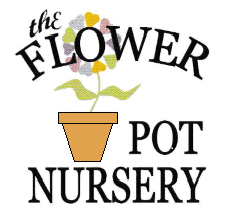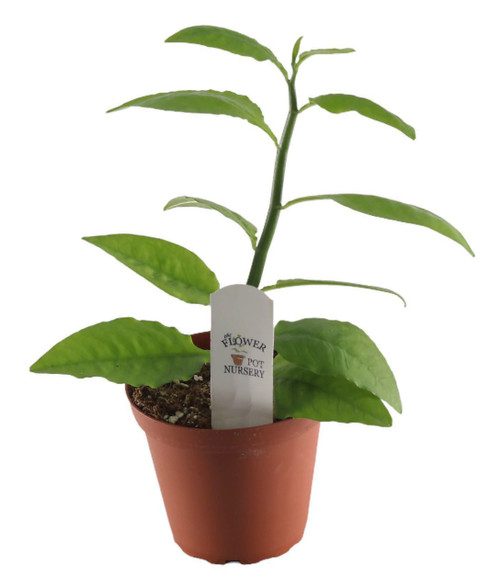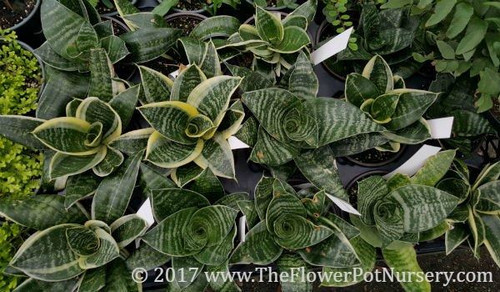Variegated Devil's Backbone / Red Bird / False Bird - Pedilanthus tithymaloides - 4” Pot
Devil's Backbone, Jacob's Ladder, Slipper Flower
Euphorbia tithymaloides
Euphorbia tithymaloides is a perennial succulent spurge. An erect shrub, the plant is also known by the scientific name Pedilanthus tithymaloides. However, the genus Pedilanthus has been submerged into the genus Euphorbia, and is more correctly known by its new name (Euphorbia tithymaloides).
Euphorbia tithymaloides has a large number of household names used by gardeners and the public. Among them are redbird flower, devil's-backbone, buck-thorn, cimora misha, christmas candle, fiddle flower, ipecacuahana, Jacob's ladder, Japanese poinsettia, Jew's slipper, Jewbush, milk-hedge, myrtle-leaved spurge, Padus-leaved clipper plant, red slipper spurge, redbird cactus, slipper flower, slipper plant, slipper spurge, timora misha, and zig-zag plant. In other parts of the world, it is known as gin-ryu (Japan); pokok lipan and penawar lipan (Indonesia); airi, baire, and agia (India); aperejo (Yoruba); sapatinho do diabo (Brazil); itamo real (Puerto Rico); pantoufle (France); and zapatilla del diablo (Mexico).
Distribution and description
Euphorbia tithymaloides is native to tropical and subtropical North America and Central America. It prefers soil that is sandy, well-drained, and nutrient-rich, particularly with higher concentrations of boron, copper, iron, manganese, molybdenum, and zinc. It is relatively intolerant of high soil salinity levels, but exhibits saline tolerance if well fertilized. The plant tends to be taller and have more biomass if it is well-watered. The plant requires a sunny area to grow in.
The shrub can grow to 6 to 8 feet (1.8 to 2.4 m) in height and generally is about 18 to 24 inches (46 to 61 cm) in width. The leaf is a simple angiosperm leaf, arranged oppositely on the stem. Each leaf is sessile (attaching directly to the plant), and about 1.4 to 3 inches (3.6 to 7.6 cm) in length. The leaves are glabrous (smooth) and acuminate in shape, with entire (smooth) edges. The veins in the leaves are pinnate.
The plant terminates in a dichotomous cyme, with a peduncle supporting each flower. The floral leaves are bifid (split in two parts) and ovate, while the involucral bracts are bright red, irregularly acuminate in shape (e.g., like a slipper), and about 0.043 to 0.051 inches (1.1 to 1.3 mm) in length with a long, thin tube. The flower is void of scent. The male pedicel is hairy, while the female is glabrous. The seed pod is about 0.30 inches (7.6 mm) long and 0.35 inches (8.9 mm) wide, and ovoid in shape (with truncated ends).
The plant generally flowers in mid-spring.
Garden and house use
Euphorbia tithymaloides was introduced as a garden plant prior to 1688. The first record of it growing in a garden was in Amsterdam. It is primarily used as an outdoor garden border plant, but certain varieties do well indoors. Because of the plant's toxicity, gardeners are cautioned to wear goggles, gloves, long-sleeved shirts, and long pants. Propagation may be by seed or cutting. Cuttings should be made above a joint, be 5 to 6 inches (13 to 15 cm) long, and planted in sandy, nutrient-rich soil and allowed to root before planting. Cuttings should be made in March – April or June – July, and from the middle or top of the main stem.
Hummingbirds are attracted to the plant's flowers. Cabbage worms are particularly fond of the plant's leaves.
Municipalities have planted Euphorbia tithymaloides in landfills, toxic waste sites, and along roadsides because it is one of the few plants which can thrive in these more difficult environments.
Other uses
In Peru, the plant is known as "cimora misha," "timora misha," or "planta magica." It is sometimes added to drinks made from mescaline-containing Trichocereus cacti (although Euphorbia tithymaloides has no known psychoactive properties).
The fast-growing nature of the plant, coupled with its ability to grow in relatively toxic soils, had led scientists in India to investigate its usefulness as a "petrocrop", a plant which could yield biofuel compounds for internal combustion engines.
1 Review Hide Reviews Show Reviews
-
Plants received
The plants were nice just smaller than expected














